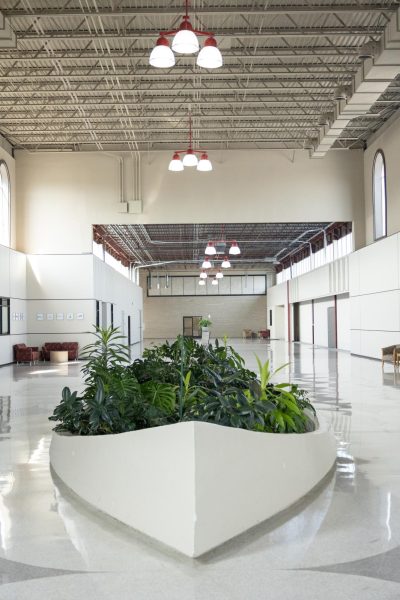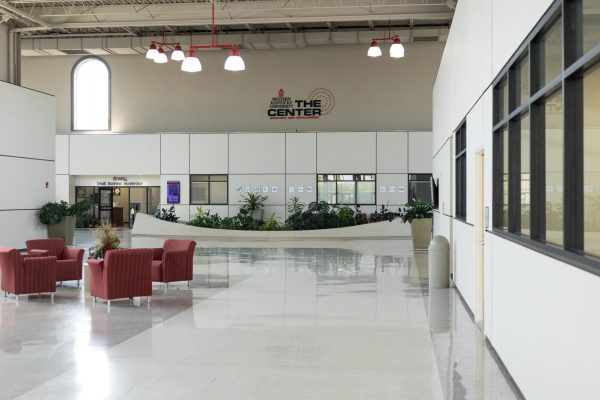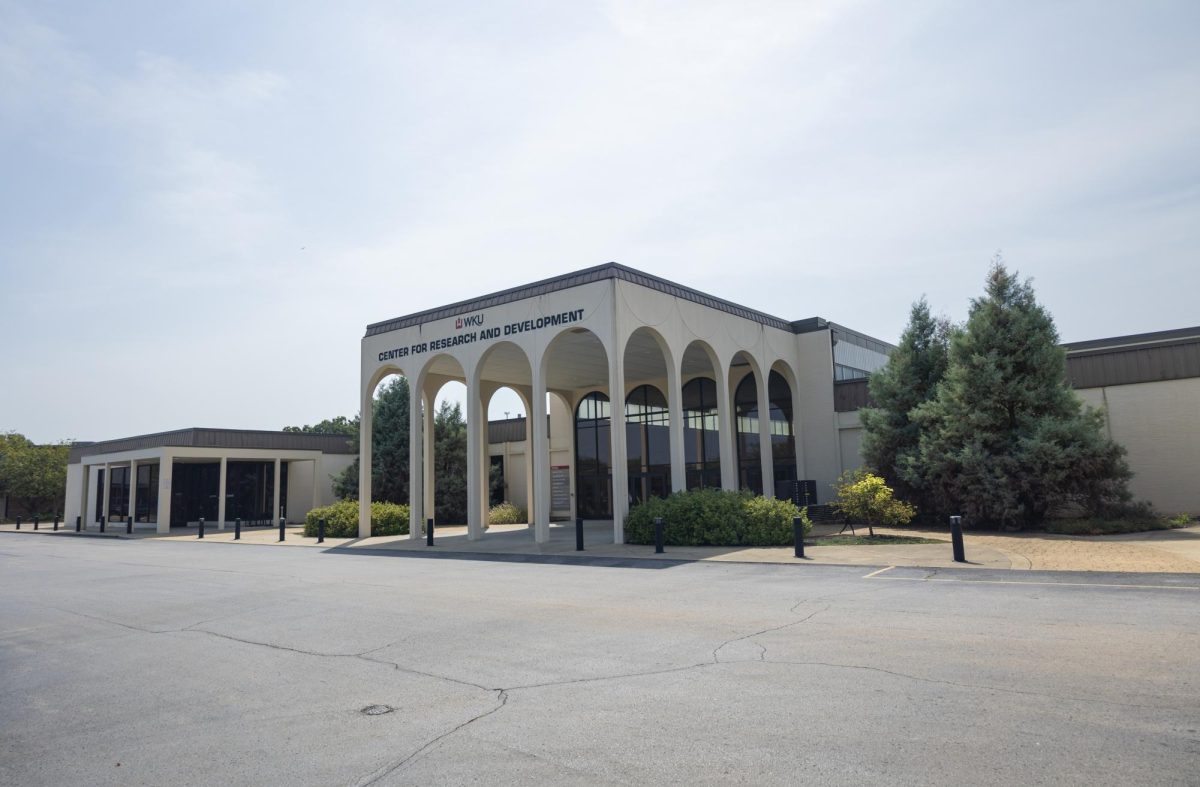In the old Bowling Green mall, which once connected to a call center and a Big Lots, nearly 50 businesses engage with each other and the community.
The renovated mall is the home of the WKU Innovation Campus, an economic and workforce development operation that provides an environment for meaningful business engagement.
Sam Ford, innovation and culture fellow at the Innovation Campus, described the campus as a part of the university that creates this meaningful engagement.
“Over time, the Innovation Campus and the concept will have multiple sides,” Ford said. “But the goal is: How does WKU leverage its resources for more meaningful engagement with the private sector in this region?”
DEVELOPMENT
Previously, the mall was renovated in 2001 to hold the WKU Center for Research and Development, which hosted various applied research labs and a multitude of company headquarters. This investment was supported by payments from the few remaining retail lease tenants and the call center.
Buddy Steen, former director of CRD and current CEO of the Innovation Campus, said the project to renovate the mall built a place where business tenants wanted to be.
“It was a pretty big project to take on,” Steen said. “It took us a couple of years to get it to where tenants wanted to be here. Companies wanted to be here. Once we were placed where corporations wanted to be, then it became pretty simple actually.” As the program progressed and Steen left his role to pursue his own startup in Nashville, the overall concept for the research and development center shifted.
“Dr. (Timothy) Caboni founded this concept here, and the idea is to really turn what was the Center for Research and Development facility into a meaningful campus, that causes the university, that helps WKU become more meaningful to business,” Steen said.
This idea, now known as the Innovation Campus, was announced at Caboni’s 2018 investiture, in which he aimed to reinvent the CRD programs and existing facilities–and in turn, elevate the regional economy and bring innovative companies to Bowling Green.
“In the spring semester before I arrived, I visited with folks all across campus to learn about things that
we were doing, and understood the research enterprise that was out on Nashville Road,” Caboni said. “And one of the first things I thought about was, what does it say about your research space when you share it with a Big Lots? It doesn’t send the right message. Then we also had a huge call center on the other side. So I came to understand the rental revenue play there, and that’s a different kind of operation than what we’re building today.”

BUILDING COMMUNITY
At the core of the Innovation Campus is its sense of collaboration, both in its development and function. Investment in the campus came from partnerships between WKU and the city of Bowling Green, the Bowling Green Chamber of Commerce and one of the six innovation hubs for the Kentucky Cabinet for Economic Development, the Central Region Ecosystem for Arts, Technology and Entrepreneurship, also known as CREATE.
“It really took us about five years, between when I announced it, and the momentum that we have today, to build that momentum, to deepen the relationships and the trust across all the different players,” Caboni said.
In 2020, Steen was invited back to work as the executive-in-residence and then as CEO for the Innovation Campus. Building a collaborative business community has been the goal of the facility since its creation. Now, rather than focus on incubating new businesses, the goal is to recruit– and retain–national and international company headquarters and offices.
“It’s because if you create a community or have a community where people want to live and work, then you can recruit just about any company that you want,” Steen said.
Caboni described the goal of the campus is now to both build companies to keep them in Bowling Green and serve as a lighthouse to attract companies here. With this shift, more good jobs will be created and students will be more likely to continue here after graduation.
With the Innovation Campus as a distinct part of the university, opportunities for students will only in- crease. Students and faculty members will have chances to pursue research, as well as build ideas into company enterprises.
“We don’t have any classrooms, but almost every single place that you go, you find students that are in high end learning environments, and work for companies on real world problems … that’s really what this is about,” Steen said. “It’s about innovating your way into having the kind of community that you want to live, work and play and learn in.”
When the research and development center was developed 20 years ago, Ford said the key question was how to keep people from leaving, but now, that perspective is different.
“Now, you’ve got people bringing their businesses here just because they like what’s happened,” Ford said. “That’s a real shift. Now, it’s talent. Now, it’s attracting people to the region through these assets.”

Organizations such as the Kentucky Thermal Institute, the Metals In- novation Initiative, Logan Aluminum, media production company Forerunner and internet company Stupp Fiber all have found their home at
the campus, alongside many others. Within the past year, other companies have announced their relocations to the campus.
Oria Health, a telehealth services company based out of Dallas, Texas, announced in July that its headquarters will be relocated to the Innovation Campus. BeingAI, an artificial intelligence corporation out of Hong Kong, will also place its U.S. headquarters here with a $3 million investment. MyXR, an engagement software and content management company, announced a regional office at the campus in April, and their lease has already begun.
“We basically create software that allows organizations to have a better connection with their users, whether it’s a student, patient, fan, employee, it goes on and on,” Hans Koch, CEO of MyXR said. “And it’s just one software, but it has 1000 plus uses.”
Koch described the company’s process of finding a suitable city for a regional office, looking at cities such as Boston and Charlotte, but said “they didn’t understand” what MyXR is trying to do.
“The Innovation Campus feels entirely different, because it allows us to be us, but way better, because now we’re part of a group that is building together,” Koch said. “That was a stark difference with these other communities that welcome companies all the time … maybe they introduce you to the Chamber of Commerce and the Chamber of Commerce doesn’t care because they have 10,000 other things to do. You’re not special, you’re not important. But here, everybody’s important.”
When recruiting and attracting companies to locate at the Innovation Campus, Caboni said “it’s a different kind of company” than what Bowling Green and Kentucky might expect to see.
“It’s high tech businesses, AI (artificial intelligence), VR (virtual reality), for example,” Caboni said. “So you look at the six announcements that we’ve had the past year, and all these folks that are making an investment in the university, in the Innovation Campus. What they have in common is they’re creating their own little ecosystem right together.” Caboni described the necessity for this as a part of Bowling Green’s changing economic standing, as the city continues to grow.
“One of the really important things is a pivot in our economy,” Caboni said. “We will continue to have manufacturing and industrial, but for Bowling Green to be successful in its next iteration as it grows and transforms itself, we have to diversify the economy.”
The campus is 285,000 square feet and 20 acres, and it holds space for business startups, company headquarters, regional offices and a “collaborative smart space” within the old call center.
The 30,000 square foot collaborative smart space that opened in Fall 2022 provides a purchasable membership for professionals to utilize the call center work space, conference rooms, fiber internet access and all other campus amenities.
“That collaborative smart space is a place where creative artistic professionals should want to go and collaborate and share their talent and their network,” Steen said.
A large draw of the collaborative smart space is its open-area design and ability to bring professionals within different organizations to the same workplace.
“Not just software has gone open source, but so has just the way people operate in their lives,” Steen said. “So have businesses, and it’s an interesting phenomena and we em- brace it here. That’s why we have the collaborative smartspace where there’s no walls.”
Choosing the Innovation Campus for a company work- place also comes with other infrastructure benefits, which most recently has been the addition of a 100 gigabit internet connection from Stupp Fiber.
“They also decided to install a 100 gigabit internet switch making this building, this city, the best connected, has the highest bandwidth of any city in the country,” Steen said.
He explained the purpose of this infrastructure is to give professionals advanced tools to work, grow and thrive at the Innovation Campus. This furthers the goal of recruiting more national and international companies to stay at the campus.
“When we’re trying to influence the development or invest in things from a community standpoint, instead of a ‘build it they will come,’ it’s build it they’re here,” Steen said.
Another key part of the campus infrastructure is fully utilizing the idea of vacancy. The model of the facility allows for companies to grow into vacant spaces if they’re successful, but they also don’t have to sign a lease for a large office if they are not.
“They built this model so that you can start in a small sized office, you start growing, and there’s always vacancy,” Ford said. “You could move into that suite down the hall that’s twice the size as fast as you grow.”
MOVING FORWARD
As the Innovation Campus has grown, so has the city of Bowling Green.
Bowling Green is projected to steadily grow its population within the next few years, with industrial and business growth also booming.
Steen attributes this in part to the city’s proximity to Nashville and the close impact of its economy, and said Bowling Green should hold strong in the areas in which it could benefit.
“One of our missions here is to make certain that as the Nashville economy comes upon us, and it gets closer every day, it’s a $200 billion GDP,” Steen said. “As soon as it comes to us, we work to make that happen for us, not to us. Which means we have to be strong and hold real value in certain areas.”
This economic growth and influence will be used to benefit and further grow the Innovation Campus. However, despite the closeness, and potential to become economically “North Nashville,” Steen said Bowling Green will remain itself, as “we don’t want to lose our identity.”

“We’re not just playing with it,” Steen said. “We actually want to be a destination worthy place. And there’s several things that we’re doing that makes it.”
As Bowling Green hosts various high-tech corporations at the Innovation Campus, and continues to bring in national and international business and attention, viewpoints on the city may change.
“It will change, we think, the way people see South Central Kentucky,” Caboni said. “Sometimes the challenge we have as a community is folks away from the state who’ve never been here have a perception of Kentucky and Bowling Green that when you arrive here, frequently is a misperception, and so we have to get people here to see what we’ve built as a community.”
The Innovation Campus is a space that Caboni hopes to show those outside the community, in order to illustrate potential for technological and business development.
“We try to get them into the Innovation Campus space to say look, this is where we are today. This is where we’re heading,” Caboni said.
Editor-in-chief Alexandria Anderson can be reached at alexandria.anderson337@topper.wku.edu.



